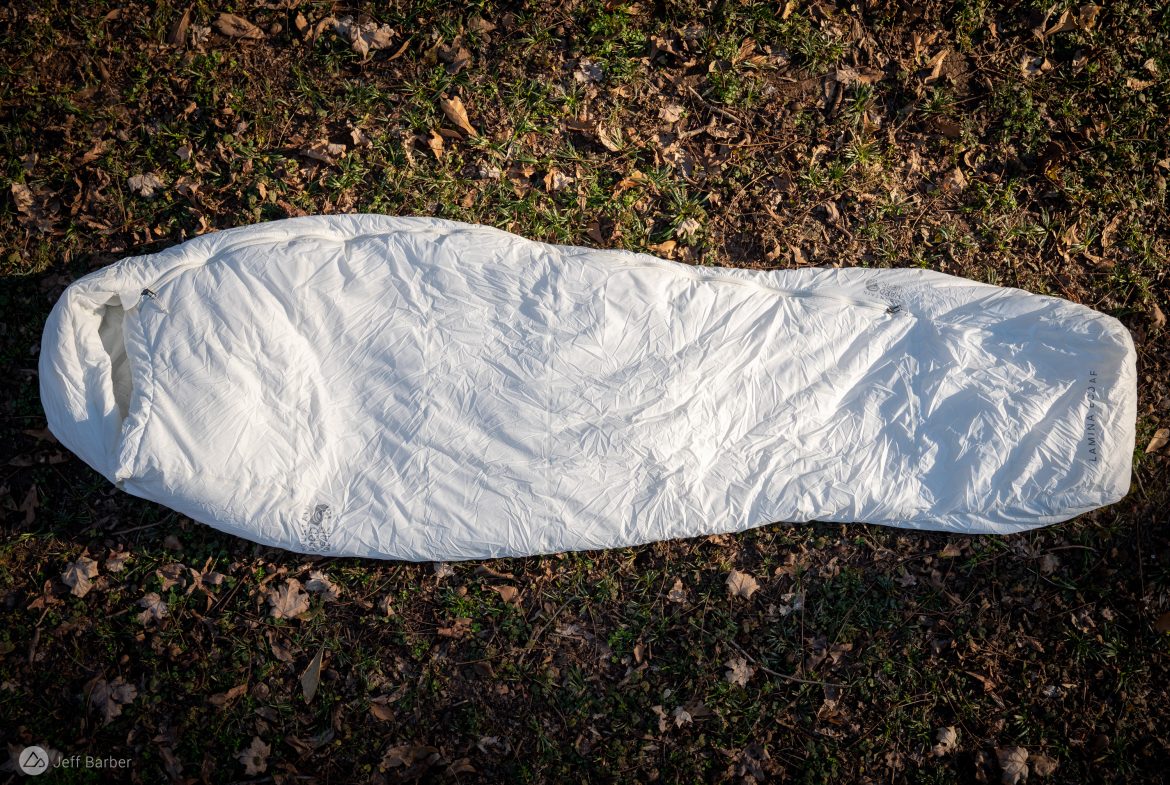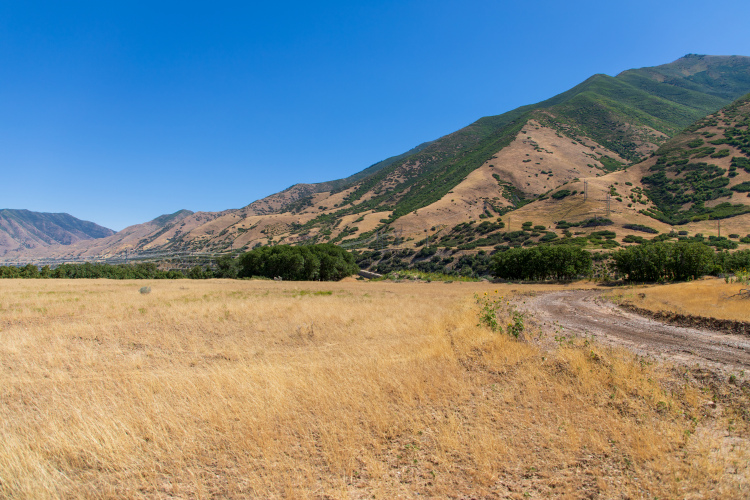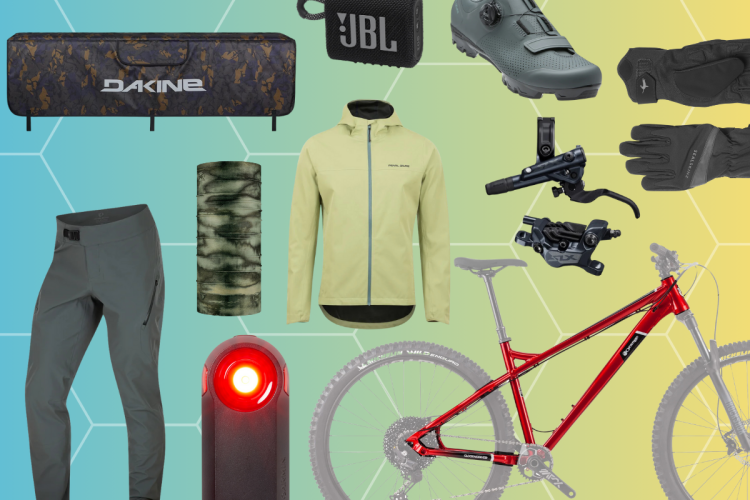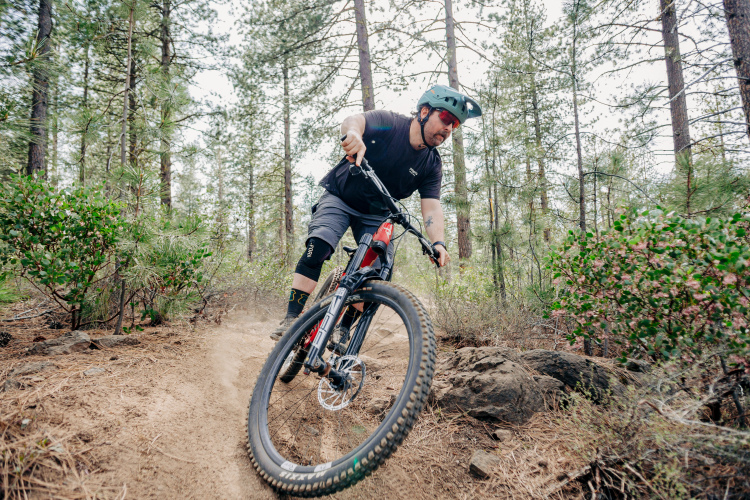
Mountain Hardwear claims their Lamina sleeping bag is Eco AF, and to be honest I never really thought about how my sleep choices affect the environment. I suppose if I did, it would probably keep me up at night, so in that way an eco-friendly sleeping bag should allow me to rest easy.
Reviewer profile height: 190cm (6’3″) weight: 75kg (165lb) testing zone: Southeast, USA
The Lamina Eco AF sleeping bag is notable for utilizing recycled, undyed fabrics and a synthetic insulating material. Fabric dyes are said to introduce potentially harsh chemicals and adds large amounts of water to the manufacturing process. The Lamina Eco AF stands out for its frosty vanilla, cloud-like appearance. While down is still considered by many to be a superior material when it comes to its weight-to-insulation value, methods for harvesting the feathery material are not without controversy. This source notes that while down is almost entirely harvested from birds already being processed for their meat, some buyers may still rightfully have concerns about its use.
Features
I tested the -8°C/15°F version of the Lamina Eco AF sleeping bag ($260 MSRP, available at Backcountry and Moosejaw) which weighs about 1100g/2.5lb on my scale. The bag comes with both a large storage bag and a smaller, packable canvas stuff sack for hitting the trail. Stuffed in its compression sack, the Lamina ECO AF squeezes down to about the size of an American football. On a recent bikepacking trip I skipped the stuff sack altogether (you know, to save weight) and placed the bag directly inside my handlebar roll. It fit inside the dry bag roll along with my air mattress and a camp pillow with plenty of room to spare.


The Lamina Eco AF is a mummy-type bag with a wide shoulder box and contoured foot box for maximum warmth and comfort. The bag can be purchased with a left- or right-hand zipper, with two pulls — one at the top, the other at the bottom — for dialing in just the right amount of ventilation during the night, or for joining two bags together. Just above the shoulders, on the inside of the bag, there’s a jacket-like, insulated collar, and the zipper stop at the neckline is shielded to avoid scratches. Finally, there’s a drawstring cord for cinching the bag down tight in the most extreme conditions.



Mountain Hardwear says the regular length bag (tested) should fit folks who are up to 182cm/6ft tall. I’m 190cm/6’3″ tall and I can fit inside comfortably. Still, it’s important to get the right size bag to avoid compressing the insulation at the head or foot, especially in the coldest conditions.
In addition to the version I tested, there is also a warmer-weather, -1°C/30°F version that is said to weigh less than 2lb, and the Lamina Eco AF is offered in three different lengths.
Pillow time on the trail
Thinking about the environment and sustainability is all well and good while I’m sitting in the warm sun, but when night falls, my concern inevitably shifts toward my own comfort and survival. My first question, as trivial as it may be, was: How will I keep this white sleeping bag clean? Camping generally involves sleeping in the dirt, or at least very close to it. On my most recent trip with the bag it rained off and on the entire time, and in my tired state, I wasn’t super careful packing and unpacking my dry bag at the end of the day. Despite contact with my gritty bags and even grittier body, I can hardly find a smudge. In fact, the photos here show the bag after all of my testing was complete and it looks almost as good as new. I was definitely careful with the bag, and perhaps a little lucky too, but overall I’m pleasantly surprised with how it’s stayed clean.

Even more impressive is how well the bag repels water. All of my tents leak to one degree or another, and the outside of the Lamina Eco AF got wet multiple times while keeping me 100% dry inside. Mountain Hardwear says the bag is coated with a “C0 durable water-repellent finish” which seems to do the trick. One thing to keep in mind, however, is that recent studies have shown DWR coatings aren’t good for our bodies or for the planet which does put a bit of a damper on the bag’s otherwise laudable eco-cred. The upside is C0 coatings use shorter chain carbon molecules than other versions of DWR like C8, which means C0 is slightly less toxic, though less water-resistant. Inside my tent during a rainstorm, however, I’ll take all the DWR coating I can get.
Sleeping bag temperature ratings are ballpark estimates at best, and everyone has a different tolerance when it comes to their ideal temperature range. Helpfully Mountain Hardware says the “comfort” zone for the bag is -3°C/26°F while the “extreme” limit is -27°C/17°F. I didn’t test it in conditions anywhere near as cold as the latter, though I can say that wet and just above freezing, the bag feels great — not too hot, and not too cold — with just a loose zip. Below freezing I would go for a full zip and a cinch around my head, and at the extreme end, I would probably add my puffy jacket inside the bag.
The side zipper is one of the smoothest I’ve used on a sleeping bag, and I never managed to get it snagged on the surrounding fabric.
Bottom line
While the Lamina Eco AF isn’t designed specifically for bikepacking I found it to be a good choice thanks to its relatively lightweight and packability. The eco-friendly materials are nice to have, and compared to the non-Eco Lamina bags, it even weighs less. While the performance is as good, or even better, than the regular Lumina, it does come at a slight cost premium.
- MSRP: $250 – $280 (15°F version)
- Available at Backcountry and other online retailers
Party laps
- Water-resistant and warm enough for most cold nights
- Packs down small and is fairly lightweight
- High quality materials and construction
- Reduced environmental footprint
Pros and cons of the Mountain Hardwear Lamina Eco AF sleeping bag.
Dirt naps
- Premium price
- Potential dirt and stain magnet







0 Comments